Menispermum canadense, Yellow Parilla
Canadian Moonseed, Pisswort, Yellow Sarsaparilla, Texas Sarsaparilla Menispermum canadense,
Menispermum canadense,Addisonia, Vol. 8 (1916)
 Menispermum canadense rhizome and rootlets
Menispermum canadense rhizome and rootletsNotes on Pharmacognosy, Otto Augustus Wall, 1902
Botanical name:
Menispermum canadense (syn. M. angulatum, M. smilacinum, Cissampelos smilacina) (America)
M. dauricum of TCM is used similarly, but we have separated them.
Parts used:
Rhizome and root
Temperature & Taste:
Cold, dry. Bitter. Slightly Toxic
Uses:
Note in the following, the designation ‘TCM’ refers to the use of M. dauricum to help show similarities.
1. Clears Heat, Resists Poison: (TCM, West)
-Throat swelling and Pain, acute Cough (TCM, West)
-Mumps (TCM), Syphilis (West)
-chronic skin conditions, Scrofula, Glandular Swellings (West)
-Fever
-Mercurial Rheumatism
-Scrofulous and Indolent Ulcers (West); Tumors; Cancer (Duke)
2. Clears Heat and Damp: (TCM, West)
-Diarrhea, Dysentery (TCM, West)
-Jaundice (TCM)
-Colitis, Gastritis (West)
-Edema from Heat
3. Clears Wind-Damp, Eases Pain: (TCM, West)
-Rheumatism, Lumbago (TCM, West)
-painful swelling of Hemorrhoids
Dose:
Usually used in Tincture form in the West)
Of the Powder: 500mg–4 grams
Decoction: 3–9 grams
Tincture (1:5): 1–2 teaspoonfuls
Dry Extract: 2–4 grains
Comment:
1. This is similar in use to the Asian Moonseed Menispermum dauricum. However, as we cannot be certain if they can be considered synonymous, we have separated them.
2. ‘Persons familiar with our common Yellow Parilla, Menispermum canadense, have a good idea of the plant that yields the calumba root of commerce. Indeed, a casual observer would take an illustration of one for the other, so closely do they resemble each other in shape of leaf, stem, and general floral appearance’. (History of the vegetable drugs of the Pharmacopoeia of the United States, Lloyd, 1911)
Substitutes:
1. Sarsaparilla
2. Scutellaria Huang Qin
3. Possibly Menispermum dauricum
Main Combinations:
1. Clear Heat and Toxin from the Blood, Syphilis, Skin disease, Scrofula:
i. Yellow Parilla (1 oz.), Burdock seed (half oz.), Digest in a quart of hot water, strain, and boil to 1 pint.
ii. Yellow Parilla, Figwort, Yellow Dock
Major Formulas:
Cautions:
Avoid large doses which may cause purging, nausea and vomiting.
Main Preparations used:
Tincture, Extract
-
Extra Info
-
History
|
‘The Canadian Moonseed is indigenous to North America, where it is quite common on the banks of streams from Canada southward to the Carolinas and westward to the Mississippi. Our first knowledge of this plant as a remedy was undoubtedly handed down from the Aborigines, who are said by Rafinesque to have used the root in scrofulosis; the early settlers also found it useful as a diuretic in strangury in horses. Its employment generally by early practitioners has been very similar to that of Sarsaparilla, ie., in mercurial, syphilitic, |
scrofulous and rheumatic diatheses; also as a laxative and tonic In general debility, atonic dyspepsia and kindred disorders; and as a remedy in pleural adhesions and inflammation of the alimentative mucous membranes. Menlspermum was admitted to the U. S. Ph. at the last revision, the rhizome and rootlets being now officinal. In the Eclectic Materia Medica its preparations are: Decoctum Menispermi, Menispermin, and as a component of Syrupus Rumecis Compositus‘. (American Medicinal Plants, Millspaugh, 1887) |
